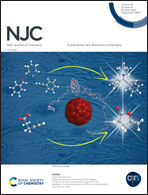An ionic liquid-modified reduced graphene oxide electrode material with favourable electrochemical properties†
Abstract
Ionic liquids (ILs) with wide electrochemical windows are increasingly used as electrolytes to improve the energy density of graphene-based supercapacitors. However, due to irreversible agglomeration during the reduction of graphene oxide (GO) to reduced graphene oxide (RGO) and less compatibility between the IL electrolyte and RGO, RGO-based electrode materials in an IL electrolyte usually exhibit poor electrochemical properties. To address these issues, we chose an ionic liquid with a similar structure to the electrolyte as a modifier and fabricated reduced graphene oxide composites modified with the chosen ionic liquid (RGO–IL) by a hydrothermal method. The integration of ILs with RGO could prevent the aggregation and restacking of GO layers and improve the compatibility between the RGO–IL electrode and IL electrolyte. The symmetrical supercapacitor assembled using the obtained RGO–IL2 electrode material showed an outstanding energy density (50.19 W h kg−1 at 0.75 kW kg−1) and excellent cycle performance (87.23% retention of the original value after 2000 cycles at 5 A g−1) in the IL electrolyte. These superior performances make RGO–IL composites one of the apposite choices of electrode materials for supercapacitors.



 Please wait while we load your content...
Please wait while we load your content...